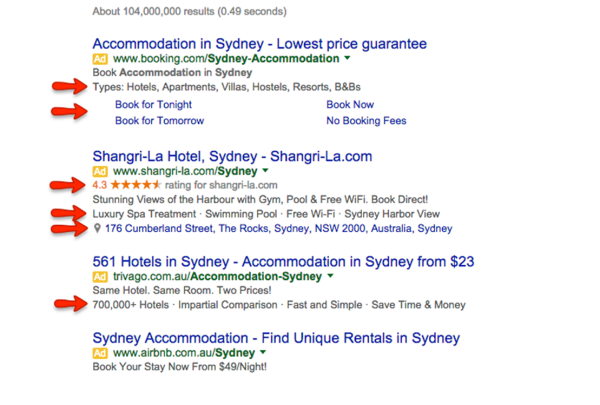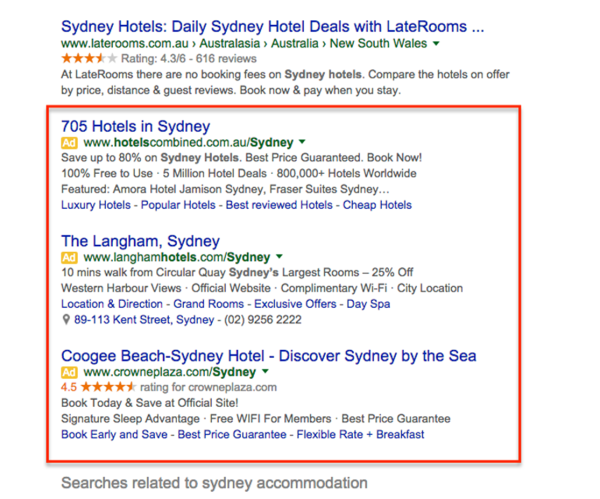
With so many businesses reliant on traffic from Google, any change it makes can rock the digital marketing landscape, especially, when it’s as big as its latest update to the layout of desktop search results.
In the same month that Alphabet, the parent company of Google, announced its above average Q4 financial results, it also made a huge change to the search results layout on desktops.
The change it has made is now live on commercial search terms and here’s what you’ll notice:
• It has removed all sidebar ads from the search results.
• It has added a fourth advert in the centre above the organic search results.
• Product listing ads (Google Shopping) and some knowledge graph ads will still appear in the right column.
Google’s most recent change to the search results page was made on 18 February. This change is a big shift in the way both users and advertisers will interact with the search engine and one of the biggest changes seen in years.
This is what a search used to look like:

And this is what it looks like now:

Visually this change is major… But the flow-on implications for both advertisers and companies reliant on search engine traffic could be astronomical.
What does this mean for business?
It’s too early to tell the exact impact this change will have on business, but there is enough information available for us to make some informed predictions.
1. Adwords click-through rates will rise for the top four ads (but decline for positions five+)
With the new layout, the top four ads will dominate the above the fold section of almost all searches.
When combined with the range of different ad extensions available, this will push down the organic search results even further. As you can see every extra extension pushes the results down by one line:

Click through rates for these ads should significantly rise, which is great news for conversion focused advertisers who have an appetite for more volume. If, of course, you are in the top few ad slots.
However, for ads that are in positions five to 10, there will likely be a large drop-off in click through rate, with these ads decreased in number and delegated to below the organic search results:

2. Cost per click will rise
With up to seven ad positions down the right hand side of the search results, previously smaller advertisers had the opportunity to write eye-catching sales copy and still get around 5% of the clicks – at a lower cost per click on each search term.
However, with the new layout this chance is essentially wiped out. If you want click throughs, you will need to bid aggressively and get into the top four positions to get any meaningful volume from a search term.
In line with recent moves, Google will most likely increase the minimum cost per click to appear in the top four positions – further increasing the cost of traffic from this network.
With many companies having sales teams relying on a certain volume of leads, or e-commerce sites with big sales targets, the cost per click increase will hit the bottom line very quickly as the cost per acquisition follows suit.
3. Organic traffic for the top positions will increase (maybe)
Whilst my initial thought was that this change would have a negative affect on organic traffic and SEO, the early data suggests otherwise. It’s actually looking like this change will show an increase in organic traffic for websites that are ranked in the top positions.
Although Google has tried over the years to make people click ads, there is still a large proportion of people who ignore the ads and scroll down to the organic results.
A study by Advanced Web Ranking in 2014 found that on desktops, 17.2% of clicks went to ads – with 11.69% of these to the top three ads and 5.51% to the ads on the right hand side. The remaining clicks went to organic search results with the click through rate correlated to the ranking position:
The recent change means that the 5.51% of traffic that previously clicked an ads on the right hand side of a search, will now have to either click the 4 paid ads at the top, or the organic results.
Here is a table that shows the click through rate of the different ad positions before this change:

This data shows us that around 2-2.69% of these clicks will go to the new ad in position four, with the remaining 2.82% – 3.51% of traffic going to the organic results.
This may not sound like much, but for a search term getting 10,000 searches a month it is an extra 282 visitors every month clicking through to the organic results. Most of this extra traffic will go to the top few results, meaning it’s even more valuable to be in these spots.
Of course every search term is different. Plus there will be many factors such as the type of search, type of ad, number of extensions etc. which will affect the click through rates. But from early estimations and data we have gathered from clients, we are seeing an increase in organic traffic due to the layout change.
Its still early days and we’re still gathering truckloads of data about this change and the overall impact it’s having on Australian business – but the early signs present both big challenges, as well as huge opportunities, and ultimately we’re excited by the changes.
However, for unprepared businesses (or agencies) that aren’t ready to move fast, there could be some significant financial impacts.
Because there are now only four spots available to advertise on with Google Adwords, the competition is going to become fierce, which means the costs will go up (just to get your ad seen). To be able to continue using Google Adwords as a profitable marketing channel you need to become a lot better at using all of its advanced features, ensure your website has a good conversion rate, and leverage a multi-channel strategy (ie remarketing, email, display etc) otherwise you won’t be able to advertise on Google in a profitable way.
Duncan Jones is head of CRO at Web Profits


